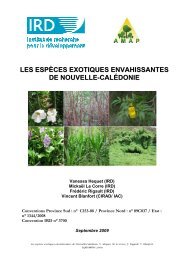The Invasive Non-Native Species Framework Strategy for ... - Defra
The Invasive Non-Native Species Framework Strategy for ... - Defra
The Invasive Non-Native Species Framework Strategy for ... - Defra
Create successful ePaper yourself
Turn your PDF publications into a flip-book with our unique Google optimized e-Paper software.
8<br />
3 Scope and Terminology<br />
3.1 This <strong>Strategy</strong> aims to address invasive non-native species issues on a GB basis and a parallel<br />
exercise is underway in the island of Ireland. Great Britain and Ireland are distinct geographical<br />
entities <strong>for</strong> this purpose; with the seas around our coasts creating a natural barrier to the<br />
movement of many species and enabling a clear focus on a geographical area. Cross-border<br />
co-operation between the administrations within GB is there<strong>for</strong>e essential <strong>for</strong> a sound<br />
ecological and ecosystem approach to tackling invasive non-native species. <strong>The</strong> 2003 policy<br />
review was conducted on a GB basis and this <strong>Strategy</strong> maintains that approach. We recognise,<br />
however, that there is a need <strong>for</strong> appropriate linkage with the all-Ireland approach to tackling<br />
invasive non-native species as this is developed.<br />
3.2 Although this <strong>Strategy</strong> relates to Great Britain, it recognises that issues will arise at both<br />
national and more local levels. Particular species and priorities will vary between the<br />
different constituent countries, as well as between regions and localities. <strong>The</strong> <strong>Strategy</strong> will<br />
there<strong>for</strong>e guide action at governmental level and provide a high-level context <strong>for</strong> regional or<br />
local initiatives.<br />
3.3 This <strong>Strategy</strong> uses the same definitions as those used in the Review of <strong>Non</strong>-<strong>Native</strong> <strong>Species</strong><br />
Policy (<strong>Defra</strong>, 2003) vii , which considered terrestrial, freshwater and marine ecosystems and also<br />
recognised that species native to one part of a country can become invasive if introduced to<br />
areas outside of their natural range. <strong>The</strong> term ‘non-native species’ (NNS) is used throughout<br />
this document and is the equivalent of ‘Alien species’ as used by the Convention on Biological<br />
Diversity. <strong>Invasive</strong> non-native species (the equivalent of ‘<strong>Invasive</strong> Alien <strong>Species</strong>’ viii or ‘IAS’) are<br />
broadly defined as species whose introduction and/or spread threaten biological diversity or<br />
have other un<strong>for</strong>eseen impacts.<br />
3.4 This <strong>Strategy</strong> is concerned with the economic, environmental and social impacts of invasive<br />
non-native species in the terrestrial, freshwater and marine environments. Since invasive<br />
potential is not constant, the scope of the <strong>Strategy</strong> is there<strong>for</strong>e all non-native species of flora<br />
and fauna with the exception of genetically modified organisms (GMOs), bacteria and viruses.<br />
Its full effect, however, is aimed at those non-native species that are known to be invasive,<br />
or identified as potentially invasive. <strong>The</strong> <strong>Strategy</strong> does not aim to address issues related to<br />
human health, nor does it cover animal or plant diseases although there are some obvious<br />
cross-linkages to such areas and diseases may be introduced via non-native species.<br />
Relationships with some other key strategies are considered in Chapter 12 on In<strong>for</strong>mation<br />
Exchange and Integration.





